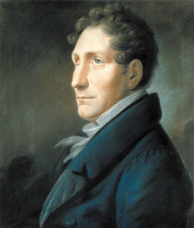Friedrich Kuhlau
Friedrich Daniel Rudolf Kuhlau (German; Danish sometimes Frederick Kulav)
(1786 – 1832) / 정조 10년-순조 32년, 46세) was a German-born Danish composer during the Classical and Romantic periods. (고전파와 낭만파 초기에 활동한 독일 태생 덴마크 음악가. 오른 쪽 눈이 실명-7세때 눈 위에 미끄러진 것이 원인- 상태인데도 나폴레옹군이 징집을 하자 이를 피해 덴마크로 피신했다. 베토벤의 영향을 많이 받았고 전반적인 삶은 그리 행복하질 못했다. 덴마크에 음악계에서는 큰 비중을 차지하고 있는 인물이다.)
* Piano Concerto in C-major, Op.7 (1810/ 24세)
Pianist: Amalie Malling
Orchestra: The Danish National Radio Symphony Orchestra / Conductor: Michael Schønwandt
Mov.I: Allegro 00:00
Mov.II: Adagio 16:54
Mov.III: Rondo: Allegro 25:01
===============================================================================
Piano Quartet in C-minor, Op.32 (1821/ 35세)
Mov.I: Allegro 00:00
Mov.II: Adagio 16:03
Mov.III: Finale: Allegro 24:25
Piano: Elisabeth Westenholz
Violin: Tutter Givskov
Viola: Lars Grunth
Cello: Asger Lund Christiansen
=================================================================================
* Piano Quartet in A-major, Op.50 (1823 / 37세)
Mov.I: Allegro 00:00
Mov.II: Adagio ma non troppo 13:09
Mov.III, Scherzo: Presto 21:20
Mov.IV: Finale: Allegro di molto 26:53
Piano: Elisabeth Westenholz
Violin: Tutter Givskov
Viola: Lars Grunth
Cello: Asger Lund Christiansen
==============================================================================
Piano Quartet in C-minor, Op.32 (1821/ 35세)
Mov.I: Allegro 00:00
Mov.II: Adagio 16:03
Mov.III: Finale: Allegro 24:25
Piano: Elisabeth Westenholz
Violin: Tutter Givskov
Viola: Lars Grunth
Cello: Asger Lund Christiansen
================================================================================
* Flute Quintet No. 3 in A major, Op. 51
Bjarne Boye Rasmussen, viola./ Lars Holm Johansen, cello. /Eyvind Rafn, flute. / Kim Sjogren, violin.
Georg Svendsen Andersen, viola.
I. Allegro con fuoco
II. egro assai quasi presto
III. Adagio sostenuto
IV. Finale: Vivace
===================================================================================
[작품 모음]
===================================================================
Friedrich Daniel Rudolf Kuhlau (German; Danish sometimes Frederick Kulav) (11 September 1786 – 12 March 1832) was a German-born Danish composer during the Classical and Romantic periods. He was a central figure of the Danish Golden Age and is immortalized in Danish cultural history through his music for Elves' Hill, the first true work of Danish National Romanticism and a concealed tribute to the absolute monarchy. To this day it is his version of this melody which is the definitive arrangement.
During his lifetime, Kuhlau was known primarily as a concert pianist and composer of Danish opera, but was responsible for introducing many of Beethoven's works, which he greatly admired, to Copenhagen audiences. Considering that his house burned down destroying all of his unpublished manuscripts, he was a prolific composer leaving more than 200 published works in most genres.
Kuhlau was born on 11 September 1786 just south of Lüneburg in Uelzen district of Lower Saxony. At the age of seven, he lost his right eye when he slipped on ice and fell. His father, grandfather, and uncle were military oboists. Even though Kuhlau was born to a poor family, his parents managed to pay for piano lessons. Later he studied the piano in Hamburg where he also had his debut as a pianist in 1804.[1]
In 1810, he fled to Copenhagen to avoid conscription in the Napoleonic Army, which overwhelmed the many small principalities and duchies of northern Germany, and in 1813 he became a Danish citizen.
Kuhlau wrote several compositions for flute and a large number of works for piano. Particularly his short pieces, sonatinas, for piano, enjoyed great popularity both in Denmark and abroad.
Beethoven, whom Kuhlau knew personally, exerted the greatest influence upon his music. Kuhlau's C major Piano Concerto, Op. 7 from 1810 displays a strong influence from Beethoven's Piano Concerto No. 1 in C major, written 14 years earlier. All three movements of the work are strongly reminiscent of the corresponding movements in Beethoven's work, making it a musical pastiche.
In addition to the above mentioned piano concerto were a string quartet and several works for piano that included all the current genres of the day: sonatas, sonatinas, waltzes, rondos and variations. He also created several works for the strings with piano (three quartets and two quintets, and several violin sonatas), works of incidental music and several operas. However, his most-often recorded and played works are several piano sonatinas and numerous works for flute. It is because of these flute works that he was nicknamed "the Beethoven of the flute" during his lifetime.
'♣ 음악 감상실 ♣ > * 음악가 별' 카테고리의 다른 글
| [네델란드계 독일]Johann Wilhelm Wilms (0) | 2014.09.10 |
|---|---|
| [쇼팽이 자신의 첫 피아노 협주곡을 헌정한 독일 음악가]Kalkbrenner, Friedrich (0) | 2014.09.09 |
| [독일]Franz Anton Hoffmeister (0) | 2014.09.07 |
| [체코- 모차르트와 인연이 있었던 음악가]Josef Mysliveček (0) | 2014.09.06 |
| Josef Mysliveček ㅡ Overtures (서곡) 모음 (0) | 2014.09.06 |
